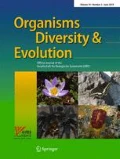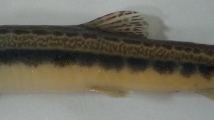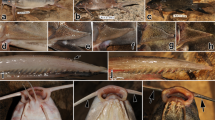Abstract
Fish scale geckos (Geckolepis) are taxonomically poorly resolved, mainly because of the difficulty of applying standard morphological characters to diagnose taxa. Three species, Geckolepis maculata, G. polylepis, and G. typica, are currently recognized from Madagascar and the Comoro Islands. Molecular studies suggested a number of operational taxonomical units within the G. maculata complex, but none of these has been formally described. The Comoran population was described as Geckolepis humbloti Vaillant 1887 but later synonymized. Prior to our study, no genetic data and little other information were available for this taxon. We revised the status of G. humbloti using molecular genetics, external morphology, and osteological characters retrieved from 3D skeletal models created using micro-computed tomography (micro-CT). Our results demonstrate that G. humbloti represents a genetic lineage strongly distinct from all other Geckolepis species. It is furthermore distinguished by a combination of external morphological characters and probably by osteology. We therefore resurrect G. humbloti Vaillant, 1887 from synonymy with G. maculata. Remarkably, this lineage is not restricted to the Comoros: A specimen from Tsingy de Bemaraha in western Madagascar falls as a closely related sister lineage to all Comoran Geckolepis in our molecular phylogenetic analysis and is osteologically almost identical with a specimen from the type locality Grand Comoro. We therefore include it in G. humbloti. The phylogenetic topology and the intraspecific genetic divergences suggest that the Comoros were colonized naturally from western Madagascar by overseas dispersal. G. humbloti is not considered as threatened, but its presence is indicative of natural or near-natural habitats.





Similar content being viewed by others
References
Angel, F. (1942). Les lézards de Madagascar. Mémoires de l’Académie Malgache, 36, 1–193.
Battistini, R., & Cremers, G. (1972). Geomorphology and vegetation of Îles Glorieuses. Atoll Research Bulletin, 159, 1–27.
Boettger, O. (1893). Katalog der Reptilien-Sammlung im Museum der Senckenbergischen Naturforschenden Gesellschaft in Frankfurt am Main. I. Teil (Rhynchocephalen, Schildkröten, Krokodile, Eidechsen, Chamäleons). Frankfurt: Gebrüder Knauer.
Daza, J. D., Abdala, V., Thomas, R., & Bauer, A. M. (2008). Skull anatomy of the miniaturized gecko Sphaerodactylus roosevelti (Squamata: Gekkota). Journal of Morphology, 269, 1340–1346.
Daza, J. D., Aurich, J., & Bauer, A. M. (2012). Anatomy of an enigma: an osteological investigation of the Namibian festive gecko (Narudasia festiva: Gekkonidae: Gekkota). Acta Zoologica, 93, 465–486.
Gamble, T., Greenbaum, E., Jackman, T. R., Russell, A. P., & Bauer, A. M. (2012). Repeated origin and loss of adhesive toepads in geckos. PLoS ONE, 7(6), e39429.
Goodman, S. M., & Benstead, J. P. (2003). The Natural History of Madagascar. University of Chicago Press. 1709 pp.
Grandidier, A. (1867). Liste des reptiles nouveaux découverts, en 1866, sur la côte sud-ouest de Madagascar. Revue et Magazine de Zoologie, 19(2), 232–234.
Greenbaum, E., Bauer, A. M., Jackman, T. R., Vences, M., & Glaw, F. (2007). A phylogeny of the enigmatic Madagascan geckos of the genus Uroplatus (Squamata: Gekkonidae). Zootaxa, 1493, 41–51.
Hawlitschek, O., & Glaw, F. (2013). The complex colonization history of nocturnal geckos (Paroedura) in the Comoros Archipelago. Zoologica Scripta, 42, 135–150.
Hawlitschek, O., & Glaw, F. (2014). Determinant species of reptiles and amphibians for the delimitation of ZNIEFF zones in Mayotte. Expert report with field surveys for the delimitation of ‘Zones naturelles d’intérêt écologique, faunistique et floristique’ (ZNIEFF, natural regions of ecological, faunal, and floral importance) in Mayotte. Mayotte, France: Expert report on behalf of the prefecture of Mayotte (French overseas department), Department for Management of Environment, Landscape, and Housing (DEAL). 43 pp.
Hawlitschek, O., Brückmann, B., Berger, J., Green, K., & Glaw, F. (2011). Integrating field surveys and remote sensing data to study distribution, habitat use and conservation status of the herpetofauna of the Comoro Islands. Zookeys, 144, 21–79.
Hawlitschek, O., Nagy, Z. T., & Glaw, F. (2012). Island evolution and systematic revision of Comoran snakes: why and when subspecies still make sense. PLoS ONE, 7(8), e42970.
Hawlitschek, O., Nagy, Z. T., Berger, J., & Glaw, F. (2013). Reliable DNA barcoding performance proved for species and island populations of Comoran squamate reptiles. PLoS ONE, 8(9), e73368.
IUCN (2001). IUCN Red List categories and criteria (version 3.1). IUCN Species Survival Commission. Gland: IUCN.
IUCN France, & MNHN (2014). The Red List of threatened species in France. Chapter reptiles and amphibians of Mayotte. Edited by Hawlitschek, O., Glaw, F., Gigot, G. & Kirchner, F. Paris, France.
Jackman, T. R., Bauer, A. M., Greenbaum, E., Glaw, F., & Vences, M. (2008). Molecular phylogenetic relationships among species of the Malagasy-Comoran gecko genus Paroedura (Squamata: Gekkonidae). Molecular Phylogenetics and Evolution, 46, 74–81.
Jerez, A., Mangione, S., & Abdala, V. (2010). Occurrence and distribution of sesamoid bones in squamates: a comparative approach. Acta Zoologica, 91, 295–305.
Jono, T. (2015). Feeding behavior on tree sap and planthopper-derived honeydew by a fish-scale gecko (Geckolepis sp.) in a dry forest of Madagascar. Current Herpetology, 34(1), 85–88.
Köhler, G., Diethert, H. H., Nussbaum, R. A., & Raxworthy, C. J. (2009). A revision of the fish scale geckos, genus Geckolepis Grandidier (Squamata, Gekkonidae) from Madagascar and the Comoros. Herpetologica, 65, 419–435.
Lemme, I., Erbacher, M., Kaffenberger, N., Vences, M., & Köhler, J. (2013). Molecules and morphology suggest cryptic species diversity and an overall complex taxonomy of fish scale geckos, genus Geckolepis. Organisms, Diversity and Evolution, 13, 87–95.
Louette, M., Meirte, D., & Jocque, R. (2004). La faune terrestre de l’archipel des Comores. MRAC, Tervuren, Belgium. Afrotropical Zoology, 293, 456.
Maddison, W. P., & Maddison, D. R. (2015). Mesquite: a modular system for evolutionary analysis. Version 3.04. http://mesquiteproject.org.
Methuen, P. A., & Hewitt, J. (1913). On a collection of reptiles from Madagascar made during the year 1911. Annals of the Transvaal Museum, 3, 183–193.
Miralles, A., Vasconcelos, R., Perera, A., Harris, D. J., & Carranza, S. (2011). An integrative taxonomic revision of the Cape Verdean skinks (Squamata, Scincidae). Zoologica Scripta, 40, 16–44.
Mocquard, F. (1909). Synopsis des familles, genres et espèces des reptiles écailleux et des batraciens de Madagascar. Nouvelles Archives du Museum National d’Histoire Naturelle, Paris, 1(5), 1–108.
Münchenberg, T., Wollenberg, K. C., Glaw, F., & Vences, M. (2008). Molecular phylogeny and geographic variation of Malagasy iguanas (Oplurus and Chalarodon). Amphibia-Reptilia, 29, 319–327.
Peters, W. (1880). Über die von Hrn J. M. Hildebrandt auf Nossi-Bé und Madagascar gasammelten Säugethiere und Amphibien. Monatsberichte der Königlich Preussischen Akademie der Wissenschaften zu Berlin, 1880, 508–511.
Ratsoavina, F. M., Vences, M., & Louis, E. E., Jr. (2012). Phylogeny and phylogeography of the Malagasy leaf-tailed geckos in the Uroplatus ebenaui group. African Journal of Herpetology, 61, 143–158.
Ratsoavina, F. M., Ranjanaharisoa, F. A., Glaw, F., Raselimanana, A., Miralles, A., & Vences, M. (2015). A new leaf-tailed gecko of the Uroplatus ebenaui group (Squamata: Gekkonidae) from Madagascar’s central eastern rainforests. Zootaxa, 4006, 143–160.
Raxworthy, C. J., Pearson, R. G., Zimkus, B. M., Reddy, S., Deo, A. J., Nussbaum, R. A., & Ingram, C. M. (2008). Continental speciation in the tropics: contrasting biogeographic patterns of divergence in the Uroplatus leaf-tailed gecko radiation of Madagascar. Journal of Zoology, 275, 423–440.
Rocha, S., Carretero, M. A., Vences, M., Glaw, F., & Harris, D. J. (2006). Deciphering patterns of transoceanic dispersal: the evolutionary origin and biogeography of coastal lizards (Cryptoblepharus) in the Western Indian Ocean region. Journal of Biogeography, 33, 13–22.
Rocha, S., Posada, D., Carretero, M. A., & Harris, D. J. (2007). Phylogenetic affinities of Comoroan and East African day geckos (genus Phelsuma): multiple natural colonisations, introductions and island radiations. Molecular Phylogenetics and Evolution, 43, 685–692.
Rocha, S., Vences, M., Glaw, F., Posada, D., & Harris, D. J. (2009). Multigene phylogeny of Malagasy day geckos of the genus Phelsuma. Molecular Phylogenetics and Evolution, 52, 530–537.
Romer, A. S. (1956). The Osteology of the Reptiles. Chicago: The University of Chicago Press.
Rosenberg, N. A. (2007). Statistical tests for taxonomic distinctiveness from observations of monophyly. Evolution, 61, 317–323.
Ross, H. A., Murugan, S., & Li, W. L. S. (2008). Testing the reliability of genetic methods of species identification via simulation. Systematic Biology, 57, 216–230.
Russell, A. P., & Bauer, A. M. (2008). The appendicular locomotor apparatus of Sphenodon and normal-limbed squamates. In C. Gans, A. S. Gaunt, & K. Adler (Eds.), The skull and Appendicular locomotor apparatus of Lepidosauria. Biology of the Reptilia (Vol. 21, pp. 1–465). Ithaca: Society for the Study of Amphibians and Reptiles.
Schubert, C., Steffen, T., & Christophers, E. (1990). Weitere Beobachtungen zur “dermolytischen Schreckhäutung” bei Geckolepis typica (Reptilia, Gekkonidae). Zoologischer Anzeiger, 224, 175–192.
Silvestro, M. (2012). raxmlGUI: a graphical front-end for RAxML. Organisms, Diversity and Evolution, 12, 335–337.
Stamatakis, A (2014). RAxML Version 8: a tool for phylogenetic analysis and post-analysis of large phylogenies. Bioinformatics 2014: open access.
Stamatakis, A. (2015). The RAxML v8.2.X Manual. Heidelberg: Heidelberg Institute for Theoretical Studies.
Vaillant, L. (1887). Matériaux pour servir l’histoire herpétologique des Iles Comores. Bulletin de la Société Philomathique de Paris, 11, 131–136.
Wang C., Scherz M. D., Montfort L., Hawlitschek O. (2015). Complementary herpetological surveys to complete the ZNIEFF database of Mayotte: results. Mayotte, France: Expert report on behalf of the prefecture of Mayotte (French overseas department), Department for Management of Environment, Landscape, and Housing (DEAL). 31 pp.
Acknowledgments
For their participation and invaluable help in the field surveys, we are grateful to Johannes Berger, Boris Brückmann, Bastian Brenzinger, Maoulida ‘Kamal’ Badroudine, Hadidja Sinane, Sheikh Moussa, Hugh Doulton, Katie Green, Ishaka Said, Amelaid Houmadi, and other members of the staff of Bristol Conservation and Science Foundation’s project in the Comoros (www.bscf.org.uk/comoros), Michel Charpentier from the Naturalistes de Mayotte, and Danny Laybourne, Guillaume Viscardi, and the other members of the DAF Mayotte. We are also grateful to Ivan Ineich (MNHN Paris), for granting access to the herpetological collection. Thanks are also due to Cynthia Wang and Bernhard Ruthensteiner for their help with micro-CT scans, Ella Z. Lattenkamp for her assistance with measurements and meristics, and Michael Franzen for general support. Authorities at Moroni (Comoros) and Mamoudzou (Mayotte) are acknowledged for the collection and export permits. Finally, we thank Michael Balke, Munich, for providing lab infrastructure, the EMBL team for handling the GenBank entries, and the editor, two anonymous reviewers, and Gunther Köhler, Frankfurt, for their helpful comments, which greatly improved this paper.
Author information
Authors and Affiliations
Corresponding author
Ethics declarations
Funding
The research was financially supported by the Mohamed bin Zayed Species Conservation Fund (project 0925157) to FG and OH (http://www.mbzspeciesconservation.org/), by DAAD grant D/09/49634 to OH (http://www.daad.de/en/), and the “Deutsche Forschungsgemeinschaft” DFG GL 314/1 to FG and BA2152/7-1 to Michael Balke (http://www.dfg.de/en/index.jsp). The “Freunde der Zoologischen Staatssammlung München” (http://www.zsm.mwn.de/freunde/) and the EES funding program of the University of Munich (http://www.eeslmu.de/eeswiki/Main_Page) provided additional financial support.
Conflict of interest
The authors declare that no conflict of interest exists.
Ethical approval
All animal handling was conducted according to guidelines approved by an ethics committee.
Electronic supplementary material
Below is the link to the electronic supplementary material.
A 1
Table with individual morphological data and locality records for all specimens studied. (XLSX 15 kb)
A 2
Interactive 3D models of the skulls of two scanned individuals of Geckolepis humbloti. ZSM 80/2010, collected from the type locality, Grand Comoro. ZSM 81/2006, collected from the Tsingy de Bemaraha. For full body models, see Appendix A3. Models can be viewed in Adobe Reader 9 or above, or Adobe Acrobat Pro X or above. Click the image to activate it. (PDF 15033 kb)
A 3
Interactive 3D models of the full skeletons of two scanned individuals of Geckolepis humbloti. ZSM 80/2010 (Grand Comoro) and ZSM 81/2006 (Tsingy de Bemaraha, western Madagascar. For skull models, see Appendix A2. Models can be viewed in Adobe Reader 9 or above, or Adobe Acrobat Pro X or above. Click the image to activate it. (PDF 17238 kb)
Rights and permissions
About this article
Cite this article
Hawlitschek, O., Scherz, M.D., Straube, N. et al. Resurrection of the Comoran fish scale gecko Geckolepis humbloti Vaillant, 1887 reveals a disjunct distribution caused by natural overseas dispersal. Org Divers Evol 16, 289–298 (2016). https://doi.org/10.1007/s13127-015-0255-1
Received:
Accepted:
Published:
Issue Date:
DOI: https://doi.org/10.1007/s13127-015-0255-1




